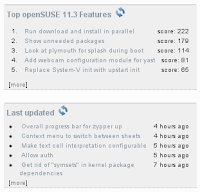openFATE - New Features the openSUSE Way: The openSUSE Ecosystem, Part 3
• James Mason
On Thursday, February 4th I gave a talk for the Bellingham Linux Users Group (BLUG), 'touring' openSUSE 11.2 as a desktop OS, and giving a broad overview of the projects and community that culminates in the openSUSE Linux distribution. For those who missed it, here's part three of the written interpretation of my discussion.



Well, the wiki puts it quite well:
openFATE is the openSUSE community interface to the Feature- and Requirements Management System of openSUSE and Novell's Linux Business. It opens the process of product planing and helps to:
- get a sorted overview of features in upcoming products
- follow and participate in the discussion by adding comments
- work on the features for the next product generation (version) and help to make openSUSE an even better Linux distribution
The feature database is public, everyone can browse all openSUSE features without the need to log in. An openSUSE account is only needed to comment, change or vote for features.

In addition, a variety of tools have been put in place to make it easy for the community to manage new feature requests. A search engine is available for supported browsers; a dashboard provides ready access to both popular and new feature requests; mailing lists, RSS feeds, and integration with Hermes (I'll explain that in part 6).
The feature that most clearly distinguishes openFATE is also the obvious one: this is not for bugs! Bugs continue to be handled through Bugzilla, which does an excellent job. By distinguishing feature requests from bugs, contributers can more easily focus on the task at hand; the bug handling teams are relieved of the the load generated by feature requests, and true 'bugs', such as security issues, are prioritized over the addition of new features.